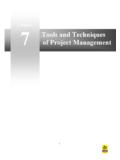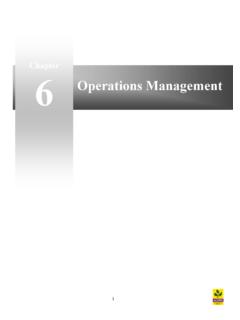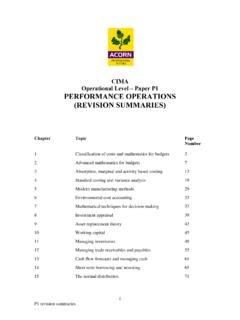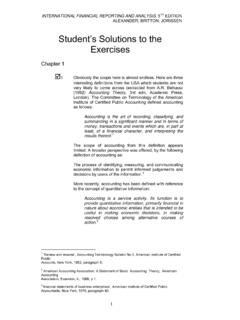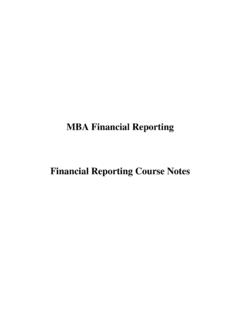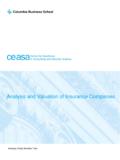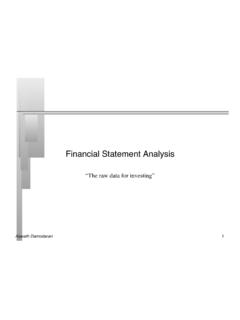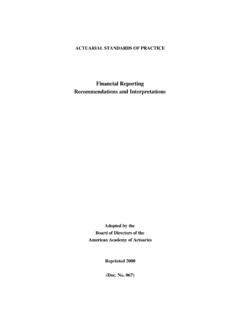Transcription of Chapter Financial Analysis 18 - acornlive.com
1 Financial Analysis Chapter 18 1 Financial Analysis The objective of Financial statements is to provide information to all the users of these accounts to help them in their decision-making. Note that most users will only have access to published Financial statements. Interpretation and Analysis of Financial statements involves identifying the users of the accounts, examining the information, analysing and reporting in a format which will give information for economic decision making. Types of users Investors look at the risk of their investment, profitability and future growth. Managers / employees have access to more information and will want to know the stability of the company and profitability.
2 Creditors are interested in the liquidity, as they just want to be paid on time. Banks are interested in the performance and liquidity of organisations for lending purposes Government departments - have various uses. Other groups including the local community on green issues, jobs etc. Analysing performance through ratios Ratios are an effective way of analysing the Financial statements. A ratio is 2 figures compared to each other, and can either be in % terms or in absolute terms. When analysing performance through the use of ratios it is important to use comparisons. A single ratio is meaningless and is only of use when compared with other ratios, competitors, and over time. Ratio uses To compare results over a period of time To measure performance against other organisations To compare results with a target To compare against industry averages 2 Ratios can be grouped into 3 main areas: 1 Performance - how well the business has done (profitability) 2 Position - short term standing of the business (liquidity) 3 Potential - what the future holds for the business Exam technique for analysing performance The following steps should be adopted when answering an exam question on analysing performance: Step 1 Review figures as they are and comment on them.
3 Step 2 Calculate relevant ratios according to performance, position and potential (if possible) 1 Performance (profitability) how well has the business done Return on capital employed (ROCE) Profit before interest & tax (PBIT) X 100% Capital employed (CE) Operating profit margin PBIT X 100% Turnover Asset turnover Turnover (number of times) Total assets (Operating profit margin x asset turnover = ROCE) Return on equity (ROE) Profit after tax_____ x 100% Shareholder funds (capital + reserves) 2 Position (liquidity) short term standing of the business Current ratio Current assets__ (number of times) Current liabilities Quick ratio Current assets inventory (number of times) Current liabilities Gearing - equity Debt capital ____ X 100% Equity (shareholders funds) Gearing total Debt capital_____ X 100% Debt + equity (total capital) Interest cover Profit before interest & tax (PBIT (number of times) Interest paid Trade payable days Trade payables_____ x 365 days Cost of sales (or purchases))
4 3 Inventory days Inventory_ x 365 days Cost of sales Trade receivable days Trade receivable x 365 days Sales Working capital cycle Trade receivable days + inventory days trade payable days 3 Potential (investor) what investors are looking at Earnings per share (EPS) Profit after tax__ Number of shares P/E ratio Share price___ Earnings per share Dividend yield Dividend per share X 100% Share price Dividend cover Earnings per share Dividend per share The above is not the complete list, but are the main ratios. Step 3 Add value to the ratios by: Interacting with other ratios and giving reasons a) State the significant fact or change ( increase or decrease) b) Explain the change or how it may have occurred by looking at the business activities and other information.
5 C) Explain the significance of the ratio in terms of implications for the future and how it fits in with the user s needs. d) Limitations of the ratio Analysis . Look at the 2 figures used to compute the ratio and criticise them. Also look at other factors which may distort the information (creative accounting, seasonal fluctuations etc.) Another way of at discussing the ratio s is to adopt the 3W s for each ratio calculated: WHAT What has happened to the figures or ratios? Have they increased or decreased? WHY Explain why the changes may have occurred by giving examples (think creatively!). WOW How do these changes affect the user of the information WOW that s great or not so great! 4 Ratios in detail We shall now look at some of the ratios in detail explain how they can be interpreted.
6 Performance ratios 1 ROCE Return on capital employed (ROCE) = Profit before interest and tax (PBIT) x 100% Capital employed The ROCE measures profitability and shows how well the business is utilising its capital to generate profits. Capital employed is debt and equity. Equity is shareholders funds (share holders funds) and debt is non current liabilities. Capital employed can be found from the statement of Financial position by taking the shareholders funds (share capital and reserves) and long term debt. The ROCE can be broken down into 2 parts, operating profit margin and asset turnover. A low ROCE is either caused by a low profit margin or high capital employed. A high ROCE is either caused by high profit margin or low capital employed.
7 It is therefore important to look at the profitability, assets, liabilities and share capital when trying to give reasons for the change in ROCE. 2 Operating profit margin Operating profit margin = PBIT x 100% Turnover This is the ratio of operating profit to sales or turnover. A high operating profit margin is due higher sales prices or low costs. Other factors to consider include inventory valuation, overhead allocation, bulk discounts and sales mix. Low profit margins are not normally good news as it suggests poor performance. But there may be other factors to consider relating to the business activities and industry. For example the company may be entering a new market which requires low selling prices.
8 Other profit margin ratios can also be calculated: Gross profit / turnover Profit after tax / turnover Advertising costs / turnover Distribution costs / turnover Cost of sales / turnover 5 3 Asset turnover Asset turnover = Turnover_____ Total assets or capital employed This shows how much sales are generated for every 1 of capital employed. A low asset turnover indicates that the business is not using its assets affectively and should either try to increase its sales or dispose of some of the assets. A company with old non current assets that are almost completely depreciated will show a high asset turnover, whereas a company with recently acquired non current assets will show a low asset turnover.
9 Different accounting policies will also give different ratios, for example using the cost model to or re-valuation model. The age of the non current assets is important in understanding the ratio. Recently acquired non current assets will not be generating revenues to their full extent. Interaction between ROCE, operating profit margin and asset turnover: ROCE = PBIT x Turnover = PBIT Turnover CE CE (ROCE = operating profit margin x asset t/o) Position ratios 1 Current ratio (CA) or working capital ratio CA = Current assets (times) Current liabilities The current ratio measures the short term solvency or liquidity; it shows the extent to which the claims of short-term creditors are covered by assets. The current ratio is essentially looking at the working capital of the company. Effective management of working capital ensures the organisation is running efficiently.
10 This will eventually result in increased profitability and positive cash flows. Effective management of working capital involves low investment in non productive assets like trade receivables, inventory and current account bank balances. Also maximum use of free credit facilities like trade payables ensures efficient management of working capital. The normal current ratio is around 2:1 but this varies within different industries. Low current ratio may indicate insolvency. High ratio may indicate not maximising return on working capital. Valuation of inventories will have an impact on the current ratio, as will year end balances and seasonal fluctuations. 6 2 Quick ratio or acid test Quick ratio = Current assets less inventories (times) Current liabilities This ratio measures the immediate solvency of a business as it removes the inventories out of the equation, which is the item least representing cash, as it needs to be sold.

